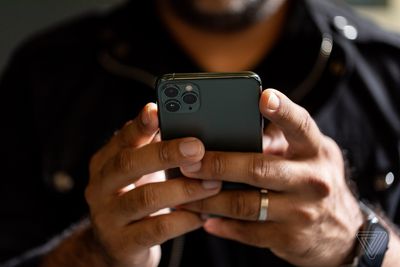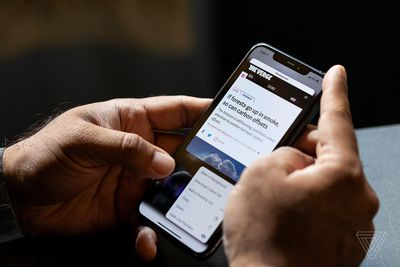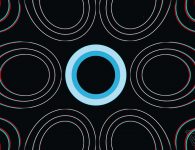
And the best camera you can get on a phone
The iPhone 11 Pro and iPhone 11 Pro Max did not arrive at the splashiest Apple event ever. Like their sibling the iPhone 11, they were mostly seen as iterative updates to Apple’s existing iPhone XS and XS Max: relatively sedate changes to already winning devices. They now have three cameras, with an ultra-wide lens joining the standard wide angle and telephoto lenses on the rear. The displays are brighter. There’s a new processor and a new version of iOS, both in their 13th iterations. And they come in a matte finish on the back, with a new midnight green option. It’s not exactly an earth-shattering list of updates.
But after using an iPhone 11 Pro and iPhone 11 Pro Max for the past week, I think they’re more than the sum of several lightly updated parts. These are some of the most well-balanced, most capable phones Apple — or anyone — has ever made. They have excellent battery life, processors that should keep them relevant for years to come, absolutely beautiful displays, and a new camera system that generally outperforms every other phone, which should get even better with a promised software update later this fall.
Yes, they’re expensive. And yes, I think most people should probably buy an iPhone 11, which has most of the same features, including the same basic camera system, for $300 less. But if you want to pay more to have the best display and the best camera, the iPhone 11 Pro is worth the premium over the iPhone 11.
The headline feature of the iPhone 11 Pro is the new camera system, but I’m going to start with battery life because I got so many questions about it. It seems like Apple made an incredibly obvious move this year: it made the phone a little thicker and put a bigger battery inside. The iPhone 11 Pro is 0.01 inch (0.4mm) thicker and 0.3 ounces (11 grams) heavier than the iPhone XS. But unless you’re comparing them directly, you won’t notice (and even then, it’s extremely subtle). The difference is a little more noticeable if you’re upgrading from something like an iPhone 7, however, as the 11 Pro is a full 1.7 ounces (50 grams) heavier.
Between the larger size and the removal of the 3D Touch system, there’s more room inside the case for a bigger battery, which seems like a big part of Apple’s claimed four-hour battery life increase from the iPhone XS and five-hour increase for the Pro Max from the XS Max.
Those numbers are fairly difficult to test, however. You’ll notice that the only hard battery life numbers Apple publishes now are fixed tests of single actions, like video and audio playback on a loop. That’s not how anyone really uses a phone, and Apple’s claims of improved battery life over the previous phones aren’t really based on those tests. Instead, the company takes a huge dataset of real-world iPhone usage and runs it against a model of the new phone that accounts for the various processor, chipset, display, and OS power improvements and the larger battery capacity.
It’s clever, but there’s no way for reviewers to repeat and verify that test. So the best I can tell you is that Apple has historically been good about meeting its battery life claims, and the iPhone 11 Pro Max I’ve been using every day for a week has consistently run for 12 to 14 hours on a single charge, with over 10 hours of screen-on time reported in the battery settings per 24-hour period.
That’s compared to 8 to 10 hours of battery life at most for my iPhone XS Max, which is a marked improvement. It’s not enough to make me stop charging at my desk throughout the day, and I’ll definitely still carry a battery pack on trips. But it’s a big bump, and it’s better than most Android phones we’ve tested.
The smaller iPhone 11 Pro also performed well. We used it all day for the review video, sent it out for several hours of shooting photo tests and 4K video in the evening, left it off the charger overnight, and it still had 50 percent of its battery left the next morning. We’ll update this review with some more real-world usage numbers for the smaller phone at the end of the week.
Apple’s also finally relented and included an 18-watt USB-C fast charger with the Pro phones, so you get a USB-C to Lightning cable as well. Apple’s USB-C charger is not the smallest or prettiest charger out there, but anything’s better than that slow 5W brick it’s been including for years.
All in all, the iPhone 11 Pro battery life has been impressive, especially compared to any prior iPhone, save for last year’s iPhone XR. Turns out, making the phone thicker and putting a bigger battery inside is a good idea.

The biggest physical difference from the XS is on the back where Apple says the rear glass is now stronger and comes in a frosted matte finish. It also integrates a glossy camera bump with three cameras. The whole back and bump is a single piece of glass that’s milled out. (The iPhone 11 is the reverse: it has a glossy back, and the camera bump is matte.) It’s a neat thing to be able to do with glass, but that doesn’t make this big, silly square look any less big and silly. It’s still a big square camera bump.
I got a lot of questions about the new matte finish, and I think it’s quite nice, especially in Apple’s new midnight green color (which is a grayish, military green that people seem especially drawn to). The back didn’t really pick up any fingerprints, but it does seem a tiny bit more slippery than the glossy back of the previous phones and the iPhone 11. I don’t think that’s a big deal; most people will stick this thing in a case. A lot of people also asked me if the matte finish scratches as easily as Google’s Pixel 3, and so far, the answer seems to be no.
Of course, the big external change to the iPhone 11 Pro is the camera system. There’s now an ultra-wide camera in addition to the standard and telephoto cameras on the back.
And these new cameras have to compete. The power of iMessage lock-in means that most iPhone users in the US will probably upgrade to another iPhone regardless of whether the camera is slightly worse or better than the Pixel, but Apple doesn’t have that advantage in huge markets like China and Europe where everyone uses WeChat or WhatsApp and switching platforms is much easier. And there’s a pride element: the iPhone camera led the industry for years, but Google’s Pixel cameras, in particular, have been outperforming the iPhone for two years now, and Chinese phone makers have been racing each other to add an endless array of photography features. I get the sense Apple is clearly feeling the pressure.
The iPhone 11 Pro has three cameras, all with different focal lengths: there’s a new ultra-wide camera with an f/2.4 13mm lens, the f/1.8 26mm main camera with a slightly improved sensor, and the telephoto camera with the same sensor as last year but a faster 52mm f/2.0 lens. (All focal lengths are in 35mm equivalent.) The f/2.2 front camera is now 12 megapixels, up from 7, and it has a wider 24mm focal length so it can pull out to a slightly wider angle in landscape for selfies, which is incredibly fun.
Apple’s also updated its Smart HDR processing system, which I was not very impressed with when I reviewed the iPhone XS and XR last year, and I have grown to dislike it even more over time. To my eyes, Smart HDR unnaturally flattened images by aggressively lifting shadows and bringing down highlights, and it crushes details with a ton of smoothing and noise reduction.
It appears Apple took all of those criticisms to heart because the iPhone 11 Pro cameras are an enormous improvement over the XS, and they beat the Pixel and Samsung’s Galaxy Note 10 Plus in most of our side-by-side comparisons. In fact, I think the iPhone 11 Pro is the best smartphone camera on the market right now.
(These image sliders are all cropped in to show detail in the photos — there are some minor cropping differences to get the sliders to align. Click on the photos in the grids to see the full-size images.)




This shot of Verge video producer Mariya Abdulkaf outside in bright sunlight is really all you need to know: this photo shouldn’t be too hard for any camera to do a good job, and every phone did just fine. But at 100 percent crop, the improvement from the iPhone XS to the iPhone 11 is stunning. The iPhone 11 is way sharper, with far more detail. I think the iPhone 11 also does a marginally better job than the Pixel 3, and it’s far more natural than the Note 10’s processing fiesta. (It’s sharpened and smoothed! C’mon now.)
Early reports indicate that the iPhone 11 sensor has a higher ISO range and faster possible shutter speeds. But Apple told me that the real improvements are due to a bump from an 8-bit rendering pipeline to 10 bits, and something it calls “semantic rendering,” which is basically an update to Smart HDR that recognizes individual elements of an image and adjusts them appropriately.
From my conversations with Apple, semantic rendering basically goes like this:
- The iPhone starts taking photos to a buffer the instant you open the camera app. So by the time you actually press the shutter button, it’s captured four underexposed frames and the photo you want. Then it grabs one overexposed frame. (This is all basically the same as the iPhone XS and the Pixel 3, except the Pixel doesn’t grab that overexposed frame.)
- Smart HDR looks for things in the photos it understands: the sky, faces, hair, facial hair, things like that.
- Then it uses the additional detail from the underexposed and overexposed frames to selectively process those areas of the image: hair gets sharpened, the sky gets de-noised but not sharpened, faces get relighted to make them look more even, and facial hair gets sharpened up.
- Smart HDR is also now less aggressive with highlights and shadows. Highlights on faces aren’t corrected as aggressively as before because those highlights make photos look more natural, but other highlights and shadows are corrected to regain detail.
- The whole image gets saved and shows up in your camera roll.
- This all happens instantly every time you take a photo.
The improvements to smart HDR are applicable across cameras. Check out this comparison of the ultra-wides on the 11 Pro and the Note 10. The Note 10 did a better job of exposing the sky, but the 11 Pro is just a much sharper photo, with more detail.
The same goes with selfies: the iPhone 11 Pro evenly pulls up shadows on Mariya’s face but preserves the contrast with the background, while the XS Max has pulled up shadows so much that it looks a little hazy. The Note 10 does all kinds of wacky skin smoothing, and while the Pixel 3 looks great, it has a little less detail than the iPhone. Look at her eyelashes. This is an impressive jump in photo quality.




Now, there are places where the iPhone doesn’t win. The XS struggled with backlit subjects, and while the 11 Pro is an improvement, it’s still not great. This photo is really blue, and there’s basically no detail in Mariya’s face. I think the Note did the best overall job here.




And while the iPhone 11 Pro is a lot better than the XS in low light, I think the Pixel still does a better job. Apple’s promised a processing update for medium to low light images called “deep fusion,” which is supposed to ship later this fall. But I wasn’t able to test it, so right now, it’s a little behind the curve. (Apple told me that deep fusion won’t be a “mode” like Night mode. It’ll just be how these medium-dark images get handled.)




Speaking of night modes, it’s also really impressive, and it preserves a ton more detail than the Pixel. Apple’s Night mode comes on automatically in the dark with a suggested exposure time, which you can tweak or turn off if you want. The Pixel shot here looks more dramatic, but look a little closer: the iPhone has preserved all of the detail in the brick and graffiti, which is basically gone in the Pixel shot.
Two more: look at all of the extra detail in the bushes in the iPhone shot, and that fence at the waterfront isn’t even there in the Pixel photo. I think the Pixel continues to produce more contrasty, dramatic images than the iPhone 11 camera, but I’d rather have the extra detail.
So the iPhone 11 camera does better in bright light than the Pixel 3 and Note 10, and Night mode beats the Pixel 3 more often than not. If the deep fusion update improves medium-to-low light performance as much as Apple says it will, the iPhone 11 will take better photos than the competition in every lighting situation.
We also spent a lot of time testing video recording, which Apple says is the best video ever on a smartphone. There’s better stabilization, all three cameras can now shoot 4K60, and you can switch between lenses if you shoot at 4K30 and below. The gap between Apple’s video camera and everyone else’s was already big, and it’s gotten bigger with the iPhone 11 Pro. But the best way to talk about that is actually on video, so go watch our video review for more.

There’s a new display on the iPhone 11 that Apple is calling the Super Retina XDR display, a reference to Apple’s fancy new Pro XDR monitor and the iPhone 11 Pro’s increased peak brightness levels: 800 nits in standard mode outdoors and 1200 nits in the highlights of HDR content (compared to 625 nits in standard mode for the XS).
I think it’s more accurate to say that this is the first real HDR display Apple’s put on a phone. The iPhone XS was theoretically capable of HDR playback, but I never found it convincing. The iPhone 11 Pro is very convincing. It’s an obvious difference when watching a Dolby Vision movie like John Wick 3, and the display overall holds its own against the Note 10’s excellent display.
Of course, Apple and Google are still in a fight over video codecs, so you can’t watch any 4K or HDR content on the iPhone 11 Pro from YouTube. This is getting past ridiculous; I am sure the iPhone has the processing power to handle Google’s VP9 codec. Apple just doesn’t want to let it, so you’re stuck watching 1080p video from YouTube until these companies sort it out.
Apple’s also tweaked its excellent True Tone display system: it now has a five-channel light sensor, down from six in the XS. Apple says it got better results by dropping the white channel and making the color channels more sensitive, and the end result is that I think the iPhone 11 Pro display has a slightly different color cast compared to my XS with True Tone on. It’s a little bit warmer and greener. True Tone is one of the best unsung features of the iPhone, and I wish Android makers would copy it sooner rather than later.
3D Touch is no more. It’s been replaced on the iPhone 11 Pro by what Apple calls Haptic Touch. Haptic Touch is just long-pressing with haptic feedback; it’s convincing, but it’s definitely long-pressing. 3D Touch was a great idea that never really panned out, and the iPhone is not really any worse for its removal. In fact, some things are a little easier to figure out, like rearranging icons on the home screen since there’s a context menu that pops up now. You don’t have to explain to people that they have to press down on the camera icon on the lock screen. Peeking at links is a little different in iOS 13, but it’s a little easier overall.
Apple says part of the reason it’s moving to Haptic Touch is so that it can bring these little features to every iOS device, including the iPad, so expect to see the company lean into it a little.
The only place where I truly missed 3D Touch was the keyboard: you could press down anywhere on the keyboard to move the cursor around on the XS. With Haptic Touch, you press and hold on the spacebar. I never really realized how many times a day I used that one specific 3D Touch feature, and I miss it. I got used to it quickly last year when I used the iPhone XR, which also lacks 3D Touch, and I’m getting used it again with the 11 Pro. And if that’s the trade-off for a bigger battery, I’ll take it.
The iPhone 11 Pro speakers are really loud and generally sound better than ever. The iPhone 11 and iPhone 11 Pro now have something called “spatial audio,” which Apple tells me is a virtual surround decoder that mostly supports Dolby formats, although it seems like games can use it without Dolby encoding as well.
Spatial audio supports 5.1 and 7.1 surround — Netflix will play in Dolby Digital 5.1 — and it also supports Dolby Atmos in movies from the iTunes store, which is a little silly for stereo speakers, but it’s there. I tested this a bunch, and, well, if you close your eyes and really believe, it sometimes sounds like sounds are coming from behind you. It’s a phone, after all. But hey: Dolby Vision and Dolby Atmos — I can’t complain.

The iPhone 11 Pro features Apple’s new A13 Bionic processor, which, as usual, benchmarks far above the competition. There’s a lot of headroom here for things like AR, games, and high-end photo and video apps, but it’s not like the A12 Bionic in the iPhone XS is slow — most of this extra power will be useful towards the end of this phone’s life, not now, at the beginning. And I just don’t think most people buying thousand-dollar “pro” phones will keep them around for more than a couple years, especially since Apple’s pushing upgrades harder than ever as iPhone sales flatten out. (Have you seen this year’s trade-in offers?) Thinking about what the company’s huge lead in smartphone processors means for this high-end phone at launch time is tough. But it’s a fast chip, and it’ll hold up if you decide to keep this phone for years to come, which is a good thing.
Face ID is a little bit faster and works at more angles, but it’s not particularly dramatic. It just works a little bit better. That’s the best kind of iterative improvement, especially since anything that encourages people to secure their phones is a good thing.
The most intriguing new feature of the iPhone 11 and 11 Pro is the new U1 chip inside, which will eventually be used for precise positioning using an ultra-wideband radio. It doesn’t do anything right now, so I wasn’t able to test it, but Apple says the forthcoming iOS 13.1 update will allow you to just point the phone at another U1 device to put it at the top of your AirDrop list. There are also lots of hints about things like unlocking car doors and locating objects, but none of that works yet, so we’ll just have to see.

Speaking of iOS 13.1… I would maybe wait to get the iPhone 11 Pro until iOS 13.1 comes out on September 30th, just 10 days after the iPhone 11 and 11 Pro launch.
My iPhone 11 and 11 Pro review units are running iOS 13.0, and iOS 13.0 is pretty damn buggy. I saw all kinds of glitches and crashes during my week of testing, as did Verge executive editor Dieter Bohn with his iPhone 11 review unit running iOS 13. The home screen has crashed and relaunched. Messages glitches out and puts the text entry field at the top of the screen. AirDrop has crashed out so hard I’ve had to restart the phone a few times to get it working again. The camera app lags from time to time. There are a lot of good new features in iOS 13, but it’s clear that Apple’s pushing hard to get it out, and I don’t think there’s any harm in waiting a tick for these bugs to get cleared up.
Assuming all the little bugs get fixed, the biggest new feature in iOS 13 is Dark Mode, which is very nice, but otherwise, it’s a lot of little things: there’s a swiping keyboard now. Reminders is a much better app. There are better photo-editing tools, and you can edit videos as well. Apple Maps keeps getting a tiny bit better every year. CarPlay has a more useful interface. Siri’s voice is slightly smoother. I love — love!— the security feature that tells you when apps are using Bluetooth or location services and prompts you to cut them off. It’s a lot of little things that add up, but if you handed this phone to someone using iOS 12, they might not even notice unless Dark Mode was on. We’ll have a full review of iOS 13 (and 13.1 when it comes out), so stay tuned for that.

The iPhone 11 Pro is an expensive phone: it starts at $999 with 64GB of storage (which doesn’t seem like enough space for this price), and the 11 Pro Max starts at $1,099. You can spec the Pro Max all the way up to $1,449 with 512GB of storage, which is a lot of money for a phone that doesn’t really do that much more than take better telephoto shots than the $699 iPhone 11.
So if you’re in the iOS ecosystem and you’re thinking about upgrading, I think the easy choice is the iPhone 11. It offers almost everything you get from the Pro for $300 less: you’ll still get the improved main camera, the fun new ultra-wide lens, the A13 processor, iOS 13, and so on.
The extra money for the Pro basically buys you a far superior display, a telephoto camera, and improved LTE performance. And if you want a smaller phone, the iPhone 11 Pro is a little smaller than the iPhone 11, which seems a tiny bit unfair to people who want smaller phones. (The entire lineup is huge, though, so if you were hoping for something to replace that aging iPhone SE, well, keep waiting.)
I’m very picky about displays and cameras, so I’m going to get a Pro. In fact, the cameras on the iPhone 11 and 11 Pro are so improved that I think they’re worth the year-over-year upgrade from last year’s models for the first time in a long time. Add in the improved battery life, and the iPhone 11 Pro stands out as a major step forward from the XS, and one of the best flagship phones of the year.
But I would also wait a couple of weeks for Apple to ship some bug fixes to iOS 13 before hitting that buy button.
Vox Media has affiliate partnerships. These do not influence editorial content, though Vox Media may earn commissions for products purchased via affiliate links. For more information, see our ethics policy.
read more at https://www.theverge.com/ by Nilay Patel
Tech









